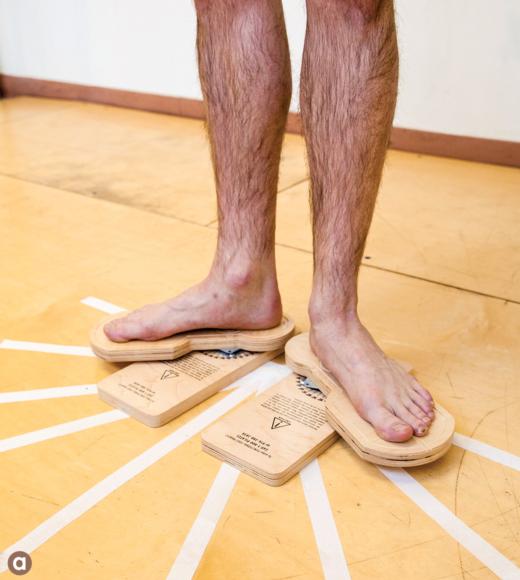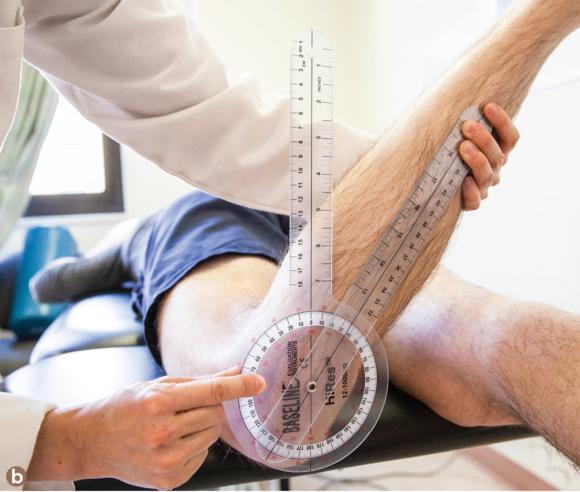Understanding the Screening Process
This is an excerpt from Dancer Wellness With Web Resource by Mary Virginia Wilmerding,Donna Krasnow.
The dancer screening process involves a collection of uniform information by a team of experts including dance educators and dance medicine specialists. This team will gather the information from individual dancers about their personal history and their training environment. Screenings also include a selection of physical measurements related to dance activities, such as measurements of muscle strength, joint motion, flexibility, and cardiovascular fitness.
These variables are obtained through tests that yield objective scores. For example, a dancer's external and internal hip rotation can be quantified in stance or prone using low-friction rotational discs or a goniometer, respectively, each of which provides a numeric value. Rotational discs are small platforms placed on ball bearings that can rotate in either direction. A goniometer is a tool used to measure the angle of a joint between two limbs. Another example could be measuring left versus right leg jump height, which can be given a numeric score when measured using measuring tapes or other instruments. Figure 10.1a and 10.1b illustrate the rotational discs and the goniometer.


Methods of measuring turnout: (a) Rotational discs measure functional turnout; (b) the goniometer measures passive turnout.
Photos courtesy of Colleen Hahn.
Purpose of Screening
The purpose of dancer screenings is twofold. First, they assist individual dancers in identifying factors in their physical and psychological makeup that can be improved in order to enhance their dancing. Second, it is to assist the dance community in better identifying the boundaries of functional capacity that dancers need in order to perform within the largest window of safety and wellness.
The ability to dance well and to dance safely is influenced by many variables, including those intrinsic to the dancer such as muscle strength, age, years of training, general health habits, past injury history, coping style, muscular flexibility, as well as variables in the environment that are extrinsic to the dancer such as shoe wear, floor surface, and teacher or school policies about rest. One method of determining the relative importance of each of these stand-alone variables to a dancer's health is to compare individual dancer findings to the average values of each of those factors from a very large sample - a group of dancers. With a large number of data points, dance medicine experts can calculate anonymous dancer norms, also called normative values. Normative values are expected values for a given population of people based on previously measured values from people in that same population. One of the most successful ways to frame answers about optimal health for each dancer is to obtain normative screening data on large groups of healthy dancers within a given dance form.
When the range of capacities of injury-free, elite dancers from a particular form are known, clinicians are equipped with normative values to which individual patient measures can be compared. This information assists in identifying whether an individual dancer possesses the attributes necessary to participate safely in his or her form of dance. Having this data is also helpful at the time of an injury occurrence and over the course of the dancer's rehabilitation, in order to evaluate how that dancer is progressing toward restoration of preinjury level of health.
Averaged group screening data can be a valuable guide to health care professionals in anticipating clinical problems. It can help teachers develop training programs that maximize performance while avoiding injury. For dancers, it may serve as a basis for comparison of their personal fitness levels with that of elite dancers and as a guide for what to focus on in their personal training to attain their peak performance.
Even though large group normative data is used for individual comparison, dance medicine specialists understand the aim is not to develop average dancers. Each dancer has a unique set of attributes that should be optimized during dance performance. A dance medicine specialist can assess whether risk factors, relative to the larger group normative values, are present that predispose a dancer or group of dancers to health problems so that a personal best health program can be put into place. Success in dance does not rely solely on any one variable. Rather, a combination of many skills forms a dancer's talent and determines success. What one dancer may excel at, another may not. A dancer who may be considered deficient in one area should be encouraged to improve in that area when possible or make up for it in another. Identifying an individual dancer's attributes and concerns is the first step toward providing the dancer with a specific counseling, treatment, or training regimen aimed at preventing injury and maximizing performance potential. Screenings provide dancers with guidance for how to progress to a successful life in dance.
For normative data to be useful, it must be valid, meaning that it has to capture accurately the information that each researcher or practitioner intended to capture, in an equally careful manner. Collecting data using validated measures in a standardized or uniform way between dance medicine and dance education professionals is necessary in order for the combined data to be trustworthy. With trustworthy information gathered, dance medicine and dance education professionals can confidently associate causes of injuries and observe their trends in order to more effectively work with dancers and dance organizations to prevent them.
Learn more about Dancer Wellness.
More Excerpts From Dancer Wellness With Web ResourceSHOP

Get the latest insights with regular newsletters, plus periodic product information and special insider offers.
JOIN NOW


